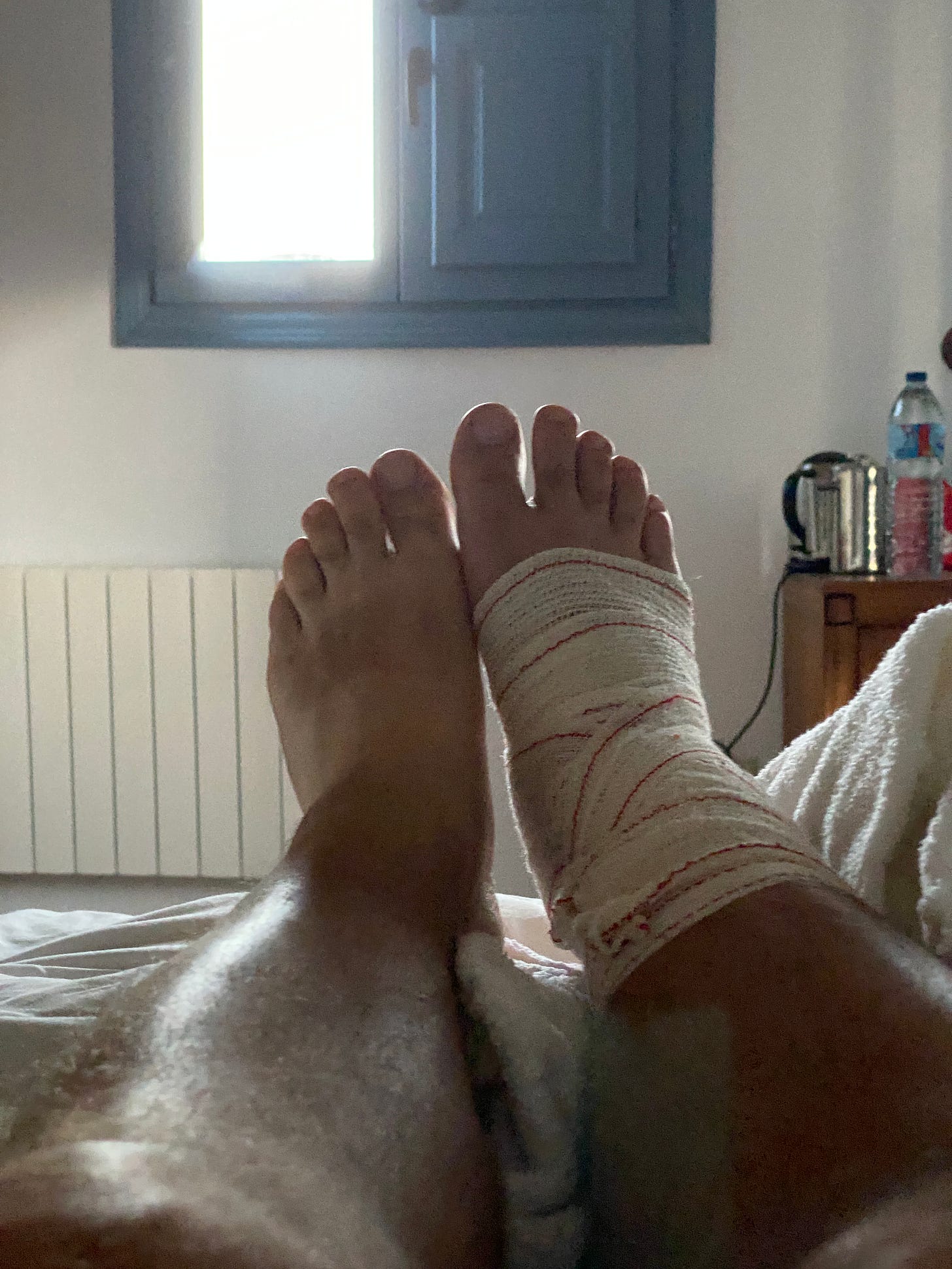Last summer I strained my left pectoral muscle at a yoga retreat. If you don't do yoga and then go to a retreat, the chances are you might not know your limits. You try too hard, push too much, get injured and are out of action for months. Rule number one of any fitness endeavour, whether running, yoga or weightlifting: don't get injured.
The pectoral pain was endurable, more nagging ache than sharp distress, but it made me curse my lack of judgement. This is what the Buddhists call the second arrow. You make a blunder (the first arrow) and then you double the pain (the second arrow) by beating yourself up for it.
A few days later, I sprained my ankle whilst trail running. I was being ultra-careful on the uneven ground and then, as I checked the map on what seemed like a flat concrete path, felt my foot turn in under itself. It was agony. I managed to hobble down to the nearest village to call for a lift, but it was a bad one and I could barely walk for a week. Loaded up on analgesics, it amused me to discover that I no longer felt the pectoral pain: I was cured. It was as if the mind could only focus on one site of trauma at a time.
As an amateur phenomenologist this fascinated me. How much of our pain is physiological and how much is generated by merely paying attention? There is a theory of the mind that suggests that consciousness is like a spotlight, highlighting certain neural pathways such as pain signals, with everything else fading into the background. By training ourselves to operate the spotlight of consciousness, we can ensure that we don't make our pain any worse than it needs to be. As Barry Graham writes: "Pain is a natural by-product of having a body and a mind—but suffering only arises from self-absorption." This also applies to psychological pain.
Over the last few months, I have been experimenting with my spotlight of consciousness. I found myself chewing over a grievance and was delighted to discover that I could substitute it by focusing on something else. The original thought became insignificant next to this vivid recent thought.
For neurotics, these kinds of distraction may be a good way of overcoming obsessive thoughts. Everyone else may need to work through the pain and develop wisdom to avoid generating more. I like the Vipassana meditation of SN Goenka, which is like a form of psychoanalysis where, instead of doing talk therapy, you perform a body scan to allow stored trauma to be released. The mindbody keeps the score.
On this point, I must mention John Sarno, the author of The Divided Mind amongst other books. Sarno was a doctor who advocated treating lower back pain, repetitive strain injury (RSI), whiplash, and other chronic pain with therapy rather than drugs. Sarno identified a disorder called Tension Myositis Syndrome (TMS) that describes how the brain orders a reduction of blood flow to a part of the body, resulting in mild oxygen deprivation, which causes pain and other symptoms. Essentially, Sarno revived the Freudian idea of hysteria, pointing out that disorders spread in epidemic fashion, and that the mind prefers physical pain to confronting unconscious emotional pain.
What I find remarkable about Sarno is that despite it sounding extremely pseudoscientific, everyone who has tried it says it works. Look under any video about Sarno and the comments are full of people describing him as a genius.
It is a technique that spreads from sceptic to sceptic without being acknowledged by mainstream science because there is no way of doing a double-blind study, as you would with a drug.
Even rationalists are pretty much on board:


What is the miracle Sarno cure? Essentially, writing essays. Seriously. Sarno recommends that the patient write about any unexpressed anger, lack of affection or childhood abuse, perfectionism or need for approval — anything that might contribute to unconscious emotional pain.
In the past, I suffered from RSI due to spending all day on the computer designing websites. My index finger got so bad from clicking I had to become ambidextrous on my mouse hand, get wrist donuts, and use a vertical mouse. I read John Sarno, did the exercises, and haven't had pain since. Even writing about this now I feel uplifted. If you're experiencing mysterious chronic pain, I highly recommend it.





This is fascinating. Thank you for sharing your experiences, I’m now going to read some Dr Sarno!
Fascinating thanks Neil! This chimes with so much of what I’ve been exploring recently. Can’t believe I hadn’t come across Dr Sarno before.